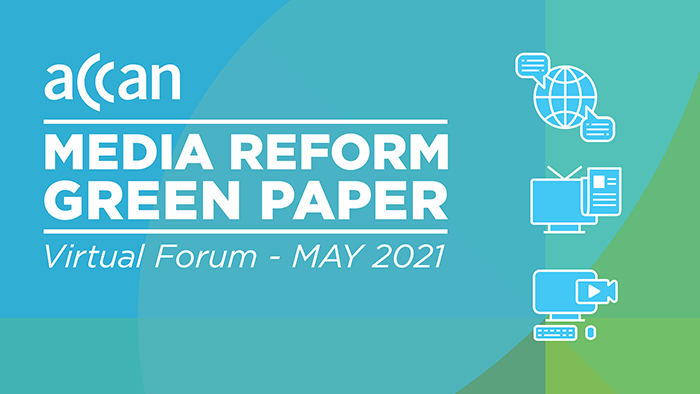Hot Issues
Welcome to the latest current affairs that impact communications consumers.
Sign up for ACCAN's weekly newsletter to have these news items sent to your email address each week.
[ List view | Detailed view ]
- Details
 Over the last ten years, faster internet speeds have dramatically impacted the way that Australians consume media. Many Australians have switched from free-to-air television (FTA) to subscription video on demand services. These include streaming services like Netflix, Stan, and Kayo and broadcast video on demand (FTA catch-up services, or BVOD). According to the ACMA, 77% of Australian households now have at least one SVOD service, compared to 61% in 20171.
Over the last ten years, faster internet speeds have dramatically impacted the way that Australians consume media. Many Australians have switched from free-to-air television (FTA) to subscription video on demand services. These include streaming services like Netflix, Stan, and Kayo and broadcast video on demand (FTA catch-up services, or BVOD). According to the ACMA, 77% of Australian households now have at least one SVOD service, compared to 61% in 20171.
With viewers switching from free-to-air to online content, there have been many questions raised about how the traditional media industry can sustain itself in a world where advertising dollars follow audiences; with less people tuning in to traditional media, these outlets are less attractive to advertisers. Regional newspapers and television channels are also closing because of loss of advertising revenue. To help keep Australia’s media sector alive, the Government needs to find a way to modernise television regulation.
With the expansion in dependency on data services and roll-out of 5G Mobile, the government is also looking at how they manage the limited spectrum used for telecommunications and broadcasting.
To encourage input and debate from interested parties about how the media laws should be changed, the Government released a Green Paper in November 2020 with proposals for new ways to fund Australian media and how it operates.
Read more: Media Reform Green Paper – Modernising Television Regulation in Australia
Write comment (0 Comments)- Details
What media reforms are proposed in the Green Paper?
Spectrum reform
The key reform proposal relates to technical changes in the way broadcasting content might be delivered. Australian broadcast television is delivered using ‘spectrum’, and there is only a finite amount of spectrum available. Currently, all of the available spectrum is being used for free-to-air television broadcasting.
However, new digital broadcasting technology means less spectrum can now be used to deliver the same broadcasting services. The Government would like television broadcasters to work together to use less spectrum because:
- If enough broadcasters agree to broadcast on less spectrum, there will be more free spectrum available to be used for other purposes. One of these potential purposes is to reallocate that spectrum to improve telecommunications networks in currently underserviced areas.
- Because the amount of spectrum available is finite, it is a valuable asset. The Government could auction off this spectrum for a profit, which it says could then be re-invested. A fund could be established to support more regional news and more Australian drama, documentary and children’s content.
- For example, the profit could be invested in more local news services in regional, rural and remote areas of Australia, and/or local television and film content production. The Green Paper doesn’t specify how much of the profit would be invested in local and regional news, or Australian content production.
Read more: Background to the Media Reform Green Paper
Write comment (0 Comments)- Details
Good afternoon,
Before I begin, I want to acknowledge that I am on the land of the Gadigal people of the Eora nation, and pay my respects to their Elders past, present and emerging..
This afternoon, there are three areas that I’d like to discuss:
- The need for reliable and fair communications
- Consumer issues with Digital Platforms and IOT
- Media Reform Green Paper
Read more: 2021 CommsDay Summit Speech by ACCAN CEO Teresa Corbin
Write comment (0 Comments)- Details
With much of Australia’s east coast currently impacted by wild weather, many Australians have found themselves evacuated or having lost telecommunications services due to the impact of this strong weather.
Which mobile phone and nbn sites have been impacted?
Optus
Visit Optus’ website to get the latest updates for customers in flood-impacted areas
Telstra
Visit Telstra’s website to get the latest updates for customers in flood-impacted areas
Read more: NSW and SE QLD Telco Floods Support Updates
Write comment (0 Comments)- Details
Consumers often experience long wait times and poor customer service when trying to resolve issues with their telcos, but how much time does this take, and at what cost?
To find out, ACCAN commissioned a survey to ask 2994 consumers about their experiences when they contact their telco. Based on the results, we have worked out the cost to consumers in time lost resolving their telco issue, instead of doing something else.
Read more: Still Waiting … the cost of customer service
Write comment (0 Comments)- Details
The No Australian Left Offline - National Webinar was held 9 December and provided a report back on the key issues from the 6 State and Territory based virtual roundtables that have taken place during 2020.
These roundtables have provided a unique opportunity for those involved to share and discuss some of the barriers that are impacting communities when it comes to getting connected and using the internet.
ACCAN and nbn Co. plan to continue this collaborative approach into 2021, working towards more affordable, reliable broadband services for all Australians.
Read more: No Australian Left Offline - National Webinar
Write comment (0 Comments)- Details
ACCAN’s Survey reveals telecommunications services are essential to small businesses but they are being let down by performance and customer service.

ACCAN surveyed 183 small and medium sized businesses between September – October to gain an understanding of SME’s experiences with their telecommunications providers during the pandemic.
Issues of speed, reliability, poor customer service and high costs were predominant. Of all the issues, speed and reliability was mentioned the most, with 39% of SMEs who provided feedback citing poor service performance, slow internet speeds, dropouts, outages, congestion and unacceptable latency.
Read more: Telco service essential to small business
Write comment (0 Comments)- Details
At ACCAN, issues relating to accessibility have always been at the forefront of our policy and consumer education efforts. After celebrating our 10th birthday and reflecting upon the positive changes that we had successfully advocated for, we started contemplating what accessibility improvements ACCAN would like to see in the communications sector in 2020 and beyond. We considered the existing communications issues affecting people with disability and wondered what issues may arise in the future.
From this, ACCAN started developing an Ideal Accessible Communications Roadmap in consultation with the disability sector. Towards the end of 2019 and the start of 2020, we sought feedback from a range of organisations supporting people with disability. We asked about the top three communications issues that were currently affecting people with disability, the top three communications issues that contributors thought would affect people with disability in the future, and suggestions for possible solutions to address these existing and anticipated communications issues. Through email conversations, phone calls and group brainstorming sessions, we received responses from 35 organisations, including Disabled Peoples Organisations, advocacy groups and disability service providers, as well as nine individuals with disability who offered their own personal insights of their lived experience.
Read more: The future is accessible
Write comment (0 Comments)- Details
As the peak body for rural and remote health in Australia, the National Rural Health Alliance has been a vocal supporter of telehealth and the many benefits that it can bring, especially for those outside of metropolitan areas.
In the wake of COVID-19, we spoke to Dr Gabrielle O’Kane, CEO of the National Rural Health Alliance to hear about how people in regional, rural and remote Australia were adapting to telehealth and what the future may hold for this technology-driven approach to healthcare.
Read more: Interview with Dr Gabrielle O’Kane, CEO of the National Rural Health Alliance
Write comment (0 Comments)- Details

Notice is hereby given that the Annual General Meeting of the ACCAN will be held via virtual meeting, on Thursday 24th September 2020 from 4.00pm.
ACCAN AGM
Date: Thursday 24th September 2020
Time: 4:00pm (AEST)
Venue: Virtual Meeting via Zoom – Please register from here by 22nd September 2020.
Read more: Notice of ACCAN Annual General Meeting
Write comment (0 Comments)- Details
ACCAN is seeking nominations for Directors to fill three (3) vacancies on its Board.
In accordance with the ACCAN Constitution, the 2020-2021 ACCAN Board will consist of nine (9) members1. Six (6) positions are continuing Directors from the 2019-2020 Board. Three (3) Directors are retiring from the Board but may be eligible for re-election as stated in the ACCAN Constitution.
In accordance with the ACCAN Constitution Board members are elected for a three year term.
In order to ensure an appropriate balance, the Board is particularly seeking candidates with legal and regulatory expertise; and/or experience in financial management and governance in a not for profit organisation; and/or an understanding of the issues affecting young consumers; and/or small businesses.
Read more: Call for nominations for the ACCAN Board
Write comment (0 Comments)- Details
Following a competitive application process, ACCAN is pleased to announce the successful Grants for 2020.
This year’s projects will explore a range of issues relevant to communications consumers, including how to protect children’s privacy when using apps, regional and rural consumers’ understanding of smart technologies, and the accessibility of video on demand services, among others.
The ACCAN Grants Program funds projects which undertake research on telecommunications issues, represent consumers or create educational tools which empower consumers to derive the greatest benefit from telecommunications products and services.
Research and outcomes achieved by Grants projects inform ACCAN's work and contribute to the broader evidence base for consumers, regulators and service providers in the telecommunications market.
The successful projects are listed below. For more information on the projects, visit the current Grants page.
Read more: 2020 ACCAN Grants projects announced
Write comment (1 Comment)